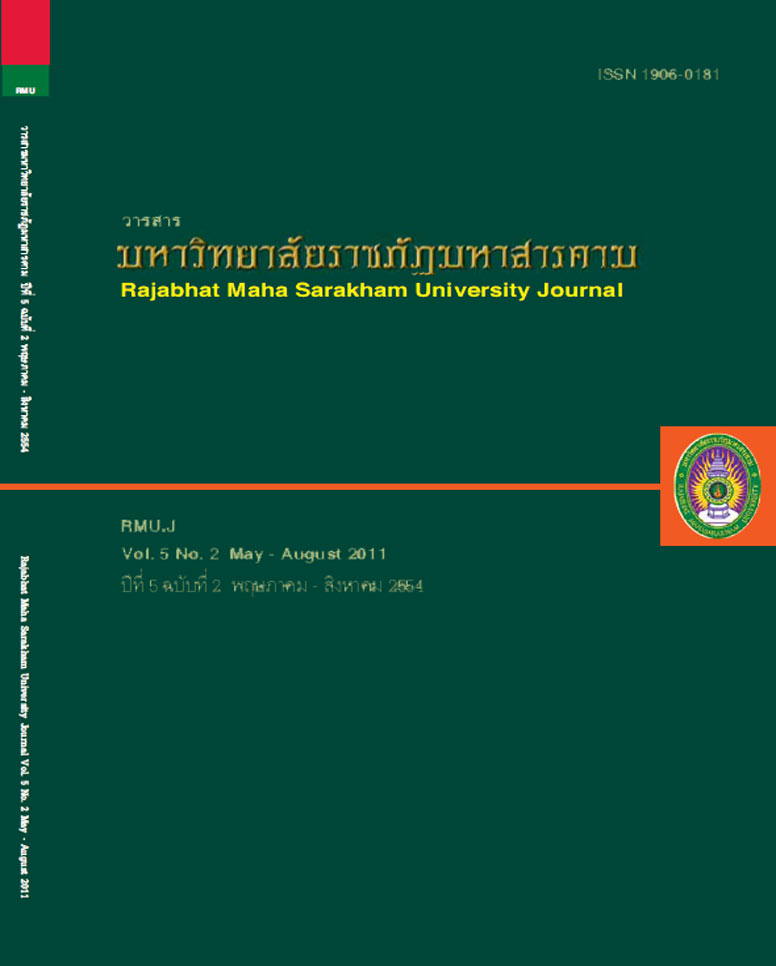การวิเคราะห์หาปริมาณโลหะหนักในสีย้อมกกสังเคราะห์ และการผลิตสีย้อมกกจากธรรมชาติ; Determination of Heavy Metals in Synthesized Dye following with Natural Colour Producting for Reed
Main Article Content
บทคัดย่อ
การศึกษาครั้งนี้มีวัตถุประสงค์ ปร
ะการแรก เพื่อวิเคราะห์หาปริมาณตะกั่วและโครเมียม ในตัวอย่างสีสังเคราะห์
จำนวน 3 ตัวอย่าง โดยใช้เทคนิคกราไฟท์เฟอร์เนชอะตอมมิกแอบซอร์พชันสเปกโทรโฟโตเมตรี ประการที่สอง ผลิตสีย้อมกก
จากวัสดุธรรมชาติ และ ประการที่สาม ศึกษาการย้อมสีกกจากวัสดุธรรมชาติ 3 ชนิดคือ ขมิ้นชัน เปลือกสะเดา และดอกอัญชัน
โดยใช้ตัวทำละลาย 2 ชนิด คือ นํ้ากลั่น และ 1% กรดแอซีติก วัดค่าสีโดยใช้เครื่อง Chroma meter : Konica Minolta
CR- 400 ผลการศึกษาพบว่า 1) สีย้อมกกสังเคราะห์สีเหลือง สีแดง และสีม่วง มีปริมาณตะกั่ว เท่ากับ 0.89 ° 0.02, 0.70 ° 0.02
และ 0.84 ° 0.03 ปริมาณโครเมียมเท่ากับ 0.86 ° 0.13, 0.40 ° 0.19 และ 0.32 ° 0.12 ไมโครกรัมต่อกิโลกรัม ตามลำดับ
2) วัสดุธรรมชาติ 3 ชนิดคือ ขมิ้นชัน เปลือกสะเดา และดอกอัญชัน สามารถผลิตสีย้อมได้สีเหลือง แดง นํ้าเงิน และม่วง โดย
ในตัวทำละลายนํ้ากลั่น และ 1% กรดแอซีติก ขมิ้นชันให้สีเหลืองและเปลือกสะเดาให้สีแดง ในขณะที่ดอกอัญชันให้สีนํ้าเงินใน
นํ้ากลั่น และสีม่วงใน 1% กรดแอซีติก 3) เส้นกกที่ย้อมด้วยสารละลายจากขมิ้นชัน โดยมีนํ้ากลั่น และ 1% กรดแอซีติก เป็นตัว
ทำละลายมีค่าความสว่าง (L*) ค่าความแดง (a*) และค่าความเหลือง (b*) เท่ากับ 63.00, 12.22, 42.64 และ 63.80, 12.19,
56.06 ตามลำดับ สารละลายจากเปลือกสะเดาที่มีนํ้ากลั่น และ 1% กรดแอซีติก เป็นตัวทำละลายมีค่า เท่ากับ 43.36, 17.69,
14.38 และ 48.88, 15.93, 13.19 ตามลำดับ และสารละลายจากดอกอัญชันที่มีนํ้ากลั่น และ 1% กรดแอซีติก เป็นตัวทำละลาย
มีค่า 52.11, 4.93, -8.69 และ 42.35, 13.52, -4.90 ตามลำดับ เมื่อทำการทดสอบความคงทนของสีต่อการล้างด้วยนํ้ากลั่น และ
ความคงทนของสีต่อแสงแดด พบว่า สีของเส้นกกที่ล้างด้วยนํ้ากลั่นหรือตากแดดทุกวัน เมื่อเวลาผ่านไป 10 วัน เส้นกกมีความ
สว่าง (L*) มากขึ้น ความแดง (a*) และความเหลือง (b*) ของเส้นกกที่ย้อมจากขมิ้นชันหรือเปลือกสะเดามีค่าลดลง เช่นเดียวกัน
กับค่าความแดง (a*) ของเส้นกกที่ย้อมด้วยดอกอัญชันที่มีค่าลดลง ส่วนค่าความเหลือง (b*) ซึ่งมีค่าติดลบน้อยลง แสดงว่า
ที่เวลาผ่านไป 10 วัน สีของเส้นกกซีดลง และความเข้มของสีลดลง เมื่อทำการเก็บในที่ร่มพบว่าที่เวลาผ่านไป 20 วัน เส้นกกมีสีซีดลง
This scientific laboratory research comprised 3 aims as 1) To determine 2 purposive heavy metals in
synthesized dye by Graphite Furnace Atomic Absorption Spectrometry, 2) To select natural plants yielding
purposive colours and 3) To study quality of those natural dye products in distilled water and 1% acetic
acid according to implementation to reed by Chroma meter: Konica Minalta CR-400. The results were
as follows; 1) According to synthesized dye of respective 3 colours of yellow, red and purple, lead level
of ppb was at 0.89 ± 0.02, 0.70 ± 0.02 and 0.84 ± 0.03 μg/kg while chromium one were at 0.86 ± 0.13,
0.40 ± 0.19 and 0.32 ± 0.12 μg/kg. 2) According to natural plants to gain colour of yellow, red, dark blue
and purple, Curcuma longa Linn. and cortex layer of Azadirechta indica var to gain colours, respectively,
of yellow and red, respectively, via both of applying distilled water and 1% acetic acid. Chitoria ternatea
Linn. did dark blue colour in distilled water and purple one in 1% acetic acid. 3) According to quality of
natural dye products, the color L, a* and b* value, respectively, of reed tinted with Curcuma longa Linn.
dye in distilled water was at 63.00,12.22 and 42.64 while the one tinted with 1% acetic acid was 63.80,
12.19 and 56.06. The one did with cortex of Azadirechta indica var showed the colour value at 43.36,
17.69 and 14.38 in distilled water and at 48.88, 15.93 and 13.19 in 1% acetic acid. The Chitoria ternatea
Linn. in distilled water and acetic acid were observed the value at 52.11, 4.93 and -8.69, and at 42.35,
13.52 and -4.90, respectively.
Moreover, after rinsing with tab water under room temperature, at 10 days L value increased contrastly
to the results of a* and b* value which yielded the same way of results after 10 days of exposing to
the sunlight. In addition, when the reed was kept inside the room to avoid the sunlight, the same results
were appealed within 20 days.
Article Details
1. บทความที่ลงตีพิมพ์ทุกเรื่องได้รับการตรวจทางวิชาการโดยผู้ประเมินอิสระ ผู้ทรงคุณวุฒิ (Peer Review) สาขาที่เกี่ยวข้อง อย่างน้อย 3 ท่าน ในรูปแบบ Double blind review
2. ข้อคิดเห็นใด ๆ ของบทความที่ลงตีพิมพ์ในวารสารมหาวิทยาลัยราชภัฏมหาสารคาม นี้เป็นของผู้เขียน คณะผู้จัดทำวารสารไม่จำเป็นต้องเห็นด้วย
3. กองบรรณาธิการวารสารมหาวิทยาลัยราชภัฏมหาสารคาม ไม่สงวนสิทธิ์การคัดลอกแต่ให้อ้างอิงแสดงที่มา


